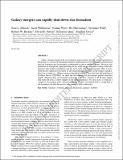Files in this item
Galaxy mergers can rapidly shut down star formation
Item metadata
| dc.contributor.author | Ellison, Sara L. | |
| dc.contributor.author | Wilkinson, Scott | |
| dc.contributor.author | Woo, Joanna | |
| dc.contributor.author | Leung, Ho-Hin | |
| dc.contributor.author | Wild, Vivienne | |
| dc.contributor.author | Bickley, Robert W. | |
| dc.contributor.author | Patton, David R. | |
| dc.contributor.author | Quai, Salvatore | |
| dc.contributor.author | Gwyn, Stephen | |
| dc.date.accessioned | 2022-10-06T14:30:07Z | |
| dc.date.available | 2022-10-06T14:30:07Z | |
| dc.date.issued | 2022-09-23 | |
| dc.identifier | 281616104 | |
| dc.identifier | c5307b0d-6f6e-4775-a618-ef3145e29968 | |
| dc.identifier | 85143892882 | |
| dc.identifier.citation | Ellison , S L , Wilkinson , S , Woo , J , Leung , H-H , Wild , V , Bickley , R W , Patton , D R , Quai , S & Gwyn , S 2022 , ' Galaxy mergers can rapidly shut down star formation ' , Monthly Notices of the Royal Astronomical Society , vol. Advance article , pp. L92-L96 . https://doi.org/10.1093/mnrasl/slac109 | en |
| dc.identifier.issn | 0035-8711 | |
| dc.identifier.other | BibCode: 2022arXiv220907613E | |
| dc.identifier.uri | https://hdl.handle.net/10023/26150 | |
| dc.description.abstract | Galaxy mergers trigger both star formation and accretion onto the central supermassive black hole. As a result of subsequent energetic feedback processes, it has long been proposed that star formation may be promptly extinguished in galaxy merger remnants. However, this prediction of widespread, rapid quenching in late stage mergers has been recently called into question with modern simulations and has never been tested observationally. Here we perform the first empirical assessment of the long-predicted end phase in the merger sequence. Based on a sample of ~500 post-mergers identified from the Ultraviolet Near Infrared Optical Northern Survey (UNIONS), we show that the frequency of post-merger galaxies that have rapidly shutdown their star formation following a previous starburst is 30-60 times higher than expected from a control sample of non-merging galaxies. No such excess is found in a sample of close galaxy pairs, demonstrating that mergers can indeed lead to a rapid halt to star formation, but that this process only manifests after coalescence. | |
| dc.format.extent | 5 | |
| dc.format.extent | 168600 | |
| dc.language.iso | eng | |
| dc.relation.ispartof | Monthly Notices of the Royal Astronomical Society | en |
| dc.subject | Galaxies: evolution | en |
| dc.subject | Galaxies: interactions | en |
| dc.subject | Galaxies: starburst | en |
| dc.subject | QB Astronomy | en |
| dc.subject | QC Physics | en |
| dc.subject | 3rd-DAS | en |
| dc.subject | MCP | en |
| dc.subject.lcc | QB | en |
| dc.subject.lcc | QC | en |
| dc.title | Galaxy mergers can rapidly shut down star formation | en |
| dc.type | Journal article | en |
| dc.contributor.institution | University of St Andrews. School of Physics and Astronomy | en |
| dc.identifier.doi | https://doi.org/10.1093/mnrasl/slac109 | |
| dc.description.status | Peer reviewed | en |
| dc.identifier.url | http://adsabs.harvard.edu/abs/2022arXiv220907613E | en |
This item appears in the following Collection(s)
Items in the St Andrews Research Repository are protected by copyright, with all rights reserved, unless otherwise indicated.

